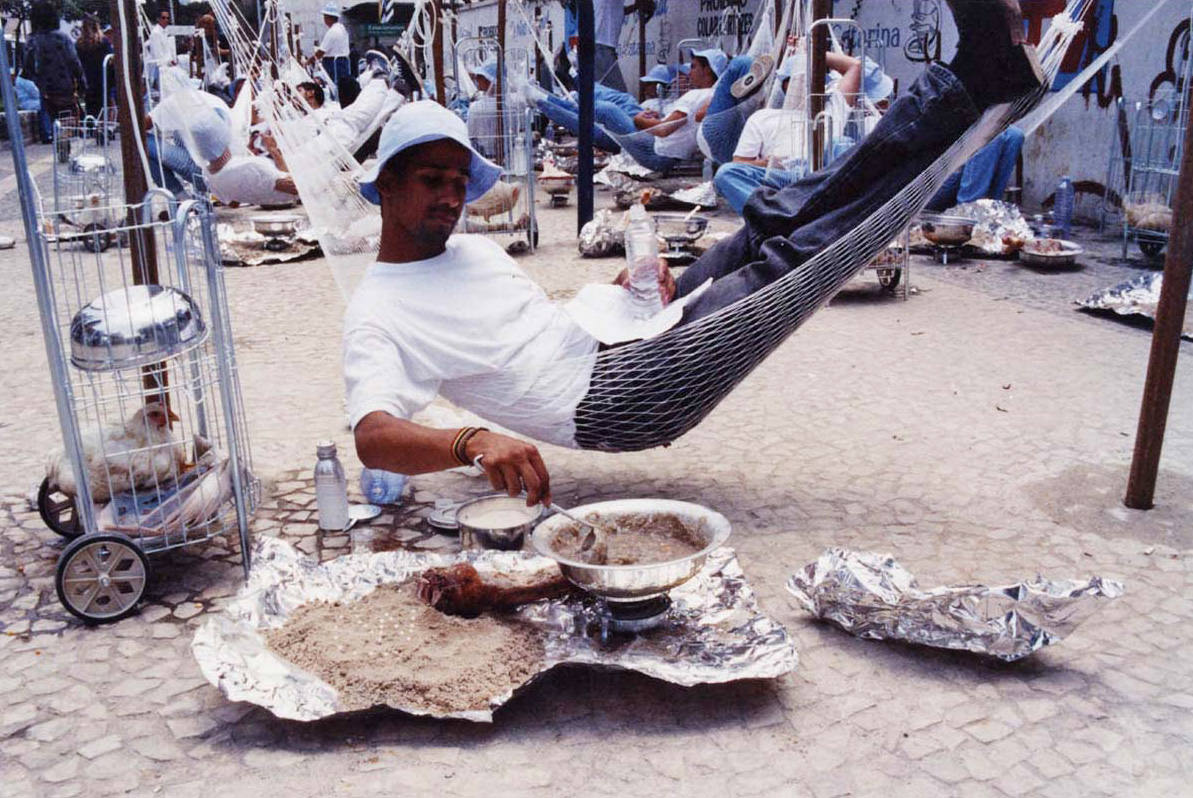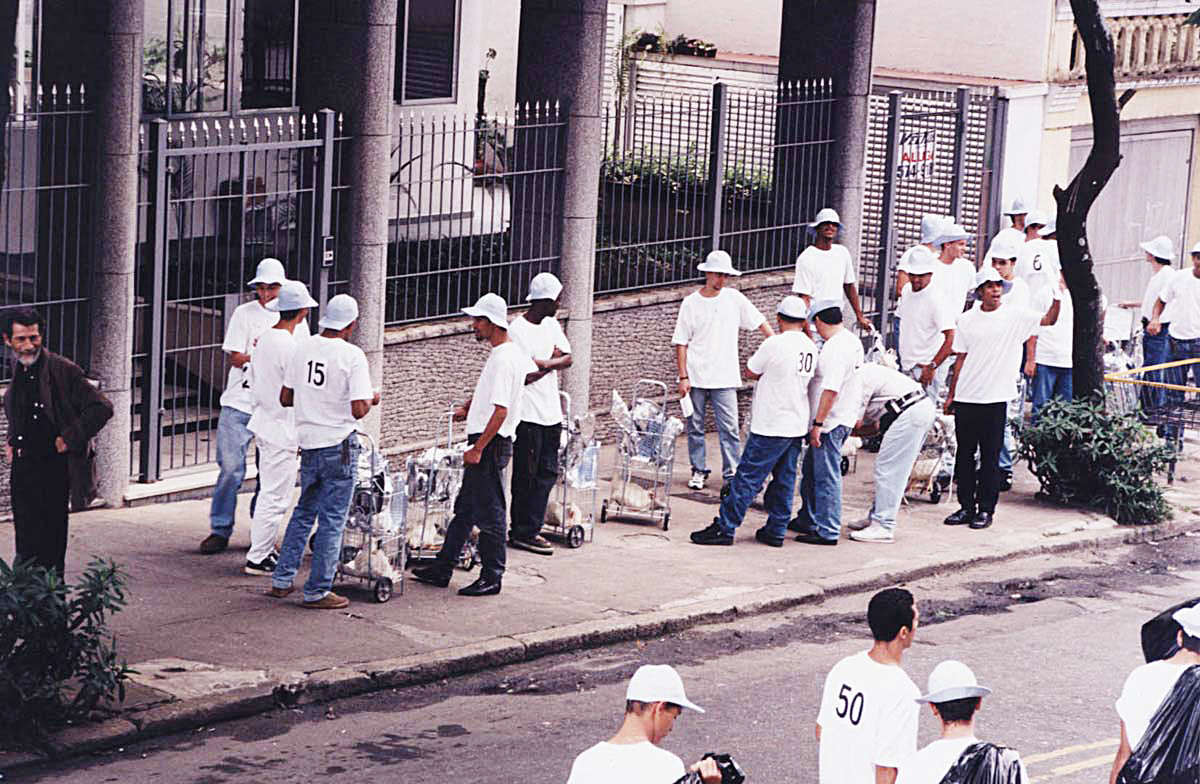100 Hammock
1997- Performance: 100 sets of folding shopping carts with iron pipes, net, aluminium foil, sand, stove, alcohol, water, lunchbox with groceries, aluminium kitchen utensils, bone, corn kernels, chicken, newspaper, pearls; 100 men wearing white T-shirts, blue cloth hats, carrying matchboxes, soap, hooks and a sheet of paper printed with Shakespeare's poem "The Phoenix and the Pigeon" in their pockets
Works arising from stories or stories resulting works. Narratives are a form of design that uses as support the imagined time and displays on the lived time, a testimony or a scene that proves that story.
100 Rede 1997
Commissioned by the Brazilian Ministry of Culture and Itaú Cultural Institute, a number of artists made public sculptures to be exhibited on Paulista Avenue for the ‘day of culture’ in São Paulo. Tunga made 100 rede. A hundred extras were recruited for this purpose. They were wearing caps and white T-shirts with a numbered sheet pinned on their back. Each of them carried a folding grocery cart. Inside these there were a hammock, a set of aluminum kitchen implements, a camping stove, water and sand. Wrapped in aluminum foil were pearls, kernels of corn and a huge bone. A live hen was trapped in the first compartment of the cart. At that time, there was talk of the low price of chicken, only one real, as though the country’s economic achievement.
In groups of five or ten, the participants marched to the project’s official launch ceremony, which was attended by political authorities. Before the ceremony finished, all the 100 members had left the place to settle 150 meters from there with their hammocks. The sidewalk had already been prepared to receive the supports for the nets. The movement of that little crowd in the middle of the ceremony divided the audience’s attention, including the press, and they chose to abandon the ceremony and follow the performers. After hanging their hammocks, the men began using the stoves and cooking some kind of soup. The occupation of space by men surrounded with their means of sustenance aroused curiosity. The indifference of these performers attracted even more attention. It was a kind of indolent manifestation. When addressed by a passer-by, the men read the poem The phoenix and the turtle.
Set of a 100 of each: folding grocery carts, hammocks, hens, bones, set of aluminum kitchen tools; and 100 men, pearls, sand, corn grains and aluminum foil.
São Paulo 1997
Paulista Avenue, in front of Santa Catarina Cultural Center at the Culture Day’, Itaú Cultural Institute and Ministry of Culture, São Paulo 1997.

- Performance: 100 sets of folding shopping carts with iron pipes, net, aluminium foil, sand, stove, alcohol, water, lunchbox with groceries, aluminium kitchen utensils, bone, corn kernels, chicken, newspaper, pearls; 100 men wearing white T-shirts, blue cloth hats, carrying matchboxes, soap, hooks and a sheet of paper printed with Shakespeare's poem "The Phoenix and the Pigeon" in their pockets

- Performance: 100 sets of folding shopping carts with iron pipes, net, aluminium foil, sand, stove, alcohol, water, lunchbox with groceries, aluminium kitchen utensils, bone, corn kernels, chicken, newspaper, pearls; 100 men wearing white T-shirts, blue cloth hats, carrying matchboxes, soap, hooks and a sheet of paper printed with Shakespeare's poem "The Phoenix and the Pigeon" in their pockets

- Performance: 100 sets of folding shopping carts with iron pipes, net, aluminium foil, sand, stove, alcohol, water, lunchbox with groceries, aluminium kitchen utensils, bone, corn kernels, chicken, newspaper, pearls; 100 men wearing white T-shirts, blue cloth hats, carrying matchboxes, soap, hooks and a sheet of paper printed with Shakespeare's poem "The Phoenix and the Pigeon" in their pockets

- Performance: 100 sets of folding shopping carts with iron pipes, net, aluminium foil, sand, stove, alcohol, water, lunchbox with groceries, aluminium kitchen utensils, bone, corn kernels, chicken, newspaper, pearls; 100 men wearing white T-shirts, blue cloth hats, carrying matchboxes, soap, hooks and a sheet of paper printed with Shakespeare's poem "The Phoenix and the Pigeon" in their pockets

- Performance: 100 sets of folding shopping carts with iron pipes, net, aluminium foil, sand, stove, alcohol, water, lunchbox with groceries, aluminium kitchen utensils, bone, corn kernels, chicken, newspaper, pearls; 100 men wearing white T-shirts, blue cloth hats, carrying matchboxes, soap, hooks and a sheet of paper printed with Shakespeare's poem "The Phoenix and the Pigeon" in their pockets

- Performance: 100 sets of folding shopping carts with iron pipes, net, aluminium foil, sand, stove, alcohol, water, lunchbox with groceries, aluminium kitchen utensils, bone, corn kernels, chicken, newspaper, pearls; 100 men wearing white T-shirts, blue cloth hats, carrying matchboxes, soap, hooks and a sheet of paper printed with Shakespeare's poem "The Phoenix and the Pigeon" in their pockets

- Performance: 100 sets of folding shopping carts with iron pipes, net, aluminium foil, sand, stove, alcohol, water, lunchbox with groceries, aluminium kitchen utensils, bone, corn kernels, chicken, newspaper, pearls; 100 men wearing white T-shirts, blue cloth hats, carrying matchboxes, soap, hooks and a sheet of paper printed with Shakespeare's poem "The Phoenix and the Pigeon" in their pockets

- Performance: 100 sets of folding shopping carts with iron pipes, net, aluminium foil, sand, stove, alcohol, water, lunchbox with groceries, aluminium kitchen utensils, bone, corn kernels, chicken, newspaper, pearls; 100 men wearing white T-shirts, blue cloth hats, carrying matchboxes, soap, hooks and a sheet of paper printed with Shakespeare's poem "The Phoenix and the Pigeon" in their pockets

- Performance: 100 sets of folding shopping carts with iron pipes, net, aluminium foil, sand, stove, alcohol, water, lunchbox with groceries, aluminium kitchen utensils, bone, corn kernels, chicken, newspaper, pearls; 100 men wearing white T-shirts, blue cloth hats, carrying matchboxes, soap, hooks and a sheet of paper printed with Shakespeare's poem "The Phoenix and the Pigeon" in their pockets